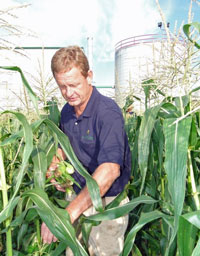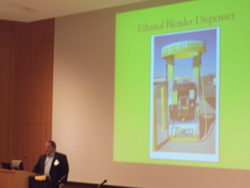A big change in the 2011 proposed targets for the Renewable Fuel Standard (RFS2) set forth by the Environmental Protection Agency (EPA) today lowers the volume for cellulosic ethanol, compared to what is in the Energy Independence and Security Act of 2007 (EISA). The proposed goal for cellulosic biofuels next year under the proposal is now a range of 5 million to 17.1 million. The mandate for this year was already cut from 100 million gallons to 6.5 million in February.
 “EPA remains optimistic that the commercial availability of cellulosic biofuel will continue to grow in the years ahead,” the agency said in a release about the proposal, but the ethanol industry is concerned that lowering the goal will lower investor interest in next generation biofuels.
“EPA remains optimistic that the commercial availability of cellulosic biofuel will continue to grow in the years ahead,” the agency said in a release about the proposal, but the ethanol industry is concerned that lowering the goal will lower investor interest in next generation biofuels.
“While this may be prudent for EPA based on market conditions, it does send a chilling effect through the investment community with respect to cellulosic ethanol technologies,” said Matt Hartwig with the Renewable Fuels Association (RFA). “EPA’s estimates underscore the need for Dept. of Energy and USDA to construct loan guarantee programs that work for cellulosic ethanol companies.”
Chris Thorne with Growth Energy says his organization has the same concerns. “Cellulosic ethanol needs much greater investment to become commercially viable. Yet, in the six years that the Department of Energy has been managing the program, it has yet to issue a single loan guarantee to a cellulosic ethanol producer,” he said.
The blend wall is also an issue for the ethanol industry to meet the RFS2 targets under EISA, according to American Coalition for Ethanol (ACE) executive director Brian Jennings. “The scaled-down targets for cellulosic biofuel clearly indicate the E10 blend wall is standing in the way of market certainty for both corn and cellulosic ethanol producers,” said Jennings. “Until the blend wall is dealt with in a meaningful way, it is going to be difficult to secure financing for and move forward with next-generation ethanol projects.”
The lowered target for cellulosic biofuels lowered the overall goal for total renewable fuels next year, from the 8.25 percent set for this year in February by EPA to 7.95 percent of total gasoline sales in
2011 or a total of 13.95 billion gallons.


 The July 8
The July 8  The EIA report concludes, in an understatement, that “the blend wall is an important event moving forward for the ethanol industry.” However, some in the ethanol industry say the blend wall is already here. According to the EIA’s
The EIA report concludes, in an understatement, that “the blend wall is an important event moving forward for the ethanol industry.” However, some in the ethanol industry say the blend wall is already here. According to the EIA’s  The Energy Independence and Security Act of 2007 (EISA) established the annual renewable fuel volume targets, reaching an overall level of 36 billion gallons in 2022. To achieve these volumes, EPA calculates a percentage-based standard for the following year. Based on the standard, each refiner, importer and non-oxygenate blender of gasoline determines the minimum volume of renewable fuel that it must ensure is used in its transportation fuel.
The Energy Independence and Security Act of 2007 (EISA) established the annual renewable fuel volume targets, reaching an overall level of 36 billion gallons in 2022. To achieve these volumes, EPA calculates a percentage-based standard for the following year. Based on the standard, each refiner, importer and non-oxygenate blender of gasoline determines the minimum volume of renewable fuel that it must ensure is used in its transportation fuel.





 NuGen Energy, a subsidiary of Central Farmers Cooperative, operates a nameplate 100 million gallon ethanol plant in Marion, South Dakota. The plant was built by Fagen, Inc. and utilizes ICM, Inc. technology. Upon completion, the investment will increase REX’s overall ownership interest of annual nameplate capacity ethanol production by approximately 33%. REX intends to fund its initial investment from cash on hand, and at April 30, 2010, REX had cash and cash equivalents of $101.4 million, including $86.1 million of cash at the parent company.
NuGen Energy, a subsidiary of Central Farmers Cooperative, operates a nameplate 100 million gallon ethanol plant in Marion, South Dakota. The plant was built by Fagen, Inc. and utilizes ICM, Inc. technology. Upon completion, the investment will increase REX’s overall ownership interest of annual nameplate capacity ethanol production by approximately 33%. REX intends to fund its initial investment from cash on hand, and at April 30, 2010, REX had cash and cash equivalents of $101.4 million, including $86.1 million of cash at the parent company.